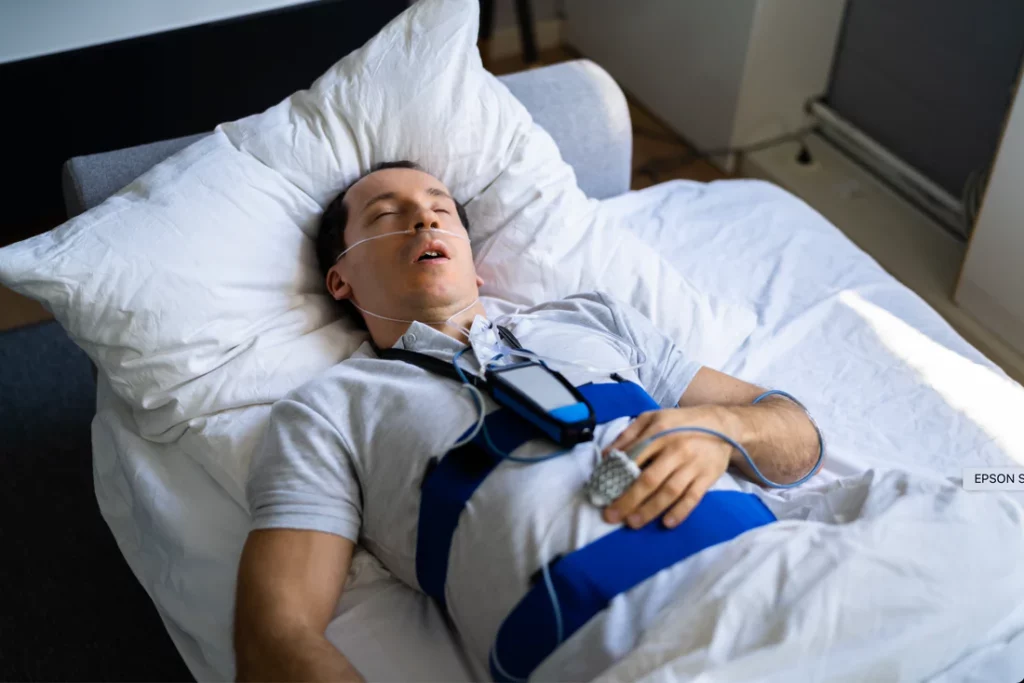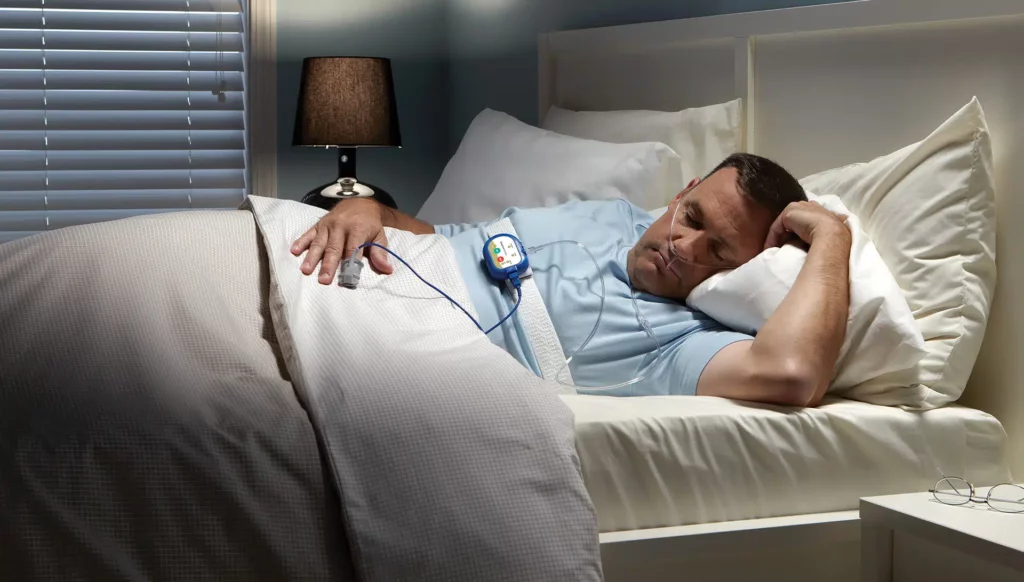What Are Home Sleep Tests and How Do They Work in Australia?
Home sleep tests are portable diagnostic tools that allow Australians to screen for sleep disorders like obstructive sleep apnea from the comfort of their own beds. These tests provide a convenient alternative to overnight clinic stays while still delivering clinically valuable data.
The home sleep test Australia procedure involves wearing compact sleep monitoring equipment overnight, typically for one to three nights. The device tracks vital physiological markers while you sleep:
- Heart rate patterns throughout the night
- Oxygen saturation levels in your blood
- Body movements and sleeping positions
- Breathing patterns and respiratory effort
You’ll receive the equipment from your healthcare provider with straightforward instructions for setup. Most devices attach comfortably to your finger, chest, or wrist, allowing natural sleep without significant disruption.
Once you’ve completed the recording period, you return the equipment for analysis. An Australian sleep physician reviews your data, examining patterns that may indicate sleep-disordered breathing or other conditions. These specialists interpret the complex interactions between your breathing, oxygen levels, and sleep quality to provide an accurate diagnosis.
The physician’s evaluation determines whether you have a sleep disorder requiring treatment, the severity of any condition detected, and the most appropriate management approach for your specific situation.
What Are the Common Symptoms That Suggest One Might Need a Home Sleep Test?
1. Persistent Loud Snoring
Persistent loud snoring represents one of the most recognizable obstructive sleep apnea symptoms. When snoring occurs regularly and loudly enough to disturb a bed partner or be heard through closed doors, it signals potential airway obstruction during sleep. This type of snoring differs from occasional, quiet snoring—it’s chronic, disruptive, and often accompanied by other concerning signs.
2. Gasping During Sleep or Choking Episodes
Gasping during sleep or choking episodes provide even stronger indicators of sleep-disordered breathing. These episodes occur when the airway becomes blocked, causing oxygen levels to drop until the brain triggers a sudden awakening to restore normal breathing. Bed partners frequently witness these frightening moments, describing them as periods where breathing stops entirely before resuming with a loud gasp or snort.
These obstructive sleep apnea symptoms warrant medical investigation because they indicate repeated breathing interruptions throughout the night. Each episode deprives the body of oxygen and fragments sleep architecture, preventing restorative rest. The severity and frequency of these symptoms directly correlate with health risks, including cardiovascular complications and metabolic dysfunction.
A home sleep test becomes necessary when these symptoms occur regularly—typically three or more nights per week over several months. The test captures objective data about breathing patterns, oxygen saturation, and sleep disruptions, providing sleep physicians with concrete evidence to confirm or rule out obstructive sleep apnea.
Can Excessive Daytime Fatigue Indicate the Need for a Home Sleep Test?
Yes, persistent daytime tiredness despite spending adequate hours in bed strongly suggests an underlying sleep disorder that disrupts your sleep quality. This type of excessive fatigue causes your body to miss out on restorative sleep cycles, leaving you exhausted regardless of how long you’ve slept.
Disrupted sleep from conditions like obstructive sleep apnea prevents you from reaching deep, restorative sleep stages. Your brain and body repeatedly wake—sometimes hundreds of times per night—to restart breathing, though you may not remember these awakenings. The result is fragmented sleep that fails to refresh you.
Daytime tiredness manifests in various ways:
- Struggling to stay awake during meetings or while driving
- Needing multiple cups of coffee just to function
- Falling asleep within minutes of sitting down
- Experiencing an overwhelming urge to nap during the day
When you consistently feel unrested after what should be sufficient sleep, your body is signalling that something is interfering with your sleep architecture. A home sleep test can identify whether breathing disruptions or other physiological issues are preventing quality rest.
Why Might Morning Headaches and Difficulty Concentrating Signal Sleep Problems?
Do you wake up with headaches that seem to appear out of nowhere? Frequent morning headaches are a telltale sign of disrupted breathing during sleep, particularly in cases of obstructive sleep apnea. When your airway becomes partially or completely blocked throughout the night, carbon dioxide builds up in your bloodstream while oxygen levels drop. This imbalance causes blood vessels in the brain to dilate, triggering those characteristic dull, throbbing headaches that greet you upon waking.
The connection between morning headaches causes and sleep-disordered breathing extends beyond just discomfort. Repeated episodes of low oxygen saturation during sleep directly impact brain function, creating a cascade of cognitive challenges during waking hours. Visit https://www.health.vic.gov.au/statewide-referral-criteria/sleep-disordered-breathing to check out more about sleep disordered breathing.
Can poor sleep quality affect your mental sharpness? Absolutely. Inadequate oxygenation throughout the night deprives your brain of the essential oxygen needed for optimal performance. This oxygen deficit manifests as cognitive impairment from poor sleep, including:
- Difficulty maintaining focus on tasks
- Slower processing speeds when making decisions
- Problems with short-term memory recall
- Reduced ability to stay alert during meetings or while driving
These concentration difficulties aren’t simply the result of feeling tired—they represent actual physiological changes in brain function caused by repeated oxygen deprivation. If you’re experiencing persistent morning headaches alongside struggles with mental clarity, these symptoms together represent one of the 7 Signs You Might Need a Home Sleep Test in Australia.
Could Mood Changes and High Blood Pressure Be Linked to Poor Sleep Quality?
Yes, both mood changes and high blood pressure can directly result from poor sleep quality. Fragmented or non-restorative sleep patterns disrupt the body’s natural restoration processes, affecting emotional regulation and cardiovascular function.
How Poor Sleep Affects Your Mood
Mood changes from poor sleep manifest in several ways:
- Increased irritability throughout the day, even in response to minor frustrations
- Heightened anxiety or feelings of being overwhelmed by routine tasks
- Reduced emotional resilience when dealing with daily stressors
- Depression-like symptoms including low motivation and social withdrawal
These emotional shifts occur because interrupted sleep prevents the brain from properly processing emotions and regulating stress hormones like cortisol.

The Connection Between High Blood Pressure and OSA
High blood pressure and OSA share a particularly concerning relationship. When breathing stops repeatedly during sleep, oxygen levels drop and the body releases stress hormones that constrict blood vessels. This pattern creates sustained cardiovascular strain.
Cardiovascular risks associated with untreated sleep disorders include:
- Resistant hypertension that doesn’t respond well to standard medications
- Increased risk of heart attack and stroke
- Irregular heart rhythms (arrhythmias)
- Heart failure progression
Research shows that treating OSA can lead to measurable reductions in blood pressure, particularly in patients whose hypertension was previously difficult to control through medication alone.
When Is a Home Sleep Test Not Recommended and What Are the Alternatives?
Home sleep tests aren’t suitable for everyone, particularly those with complex medical conditions that could affect test accuracy or safety. Certain contraindications for home sleep tests require careful consideration before proceeding.
Patients with the following conditions should typically avoid home testing:
- Severe chronic obstructive pulmonary disease (COPD) with resting hypoxia or hypercapnia
- Neuromuscular diseases affecting respiratory function
- Significant cardiovascular disease requiring close monitoring
- Morbid obesity that may complicate breathing measurements
- Chronic narcotic use that affects respiratory patterns
For these individuals, polysomnography vs home testing becomes a critical decision. Lab-based polysomnography offers comprehensive monitoring in a controlled clinical environment, recording brain waves, eye movements, muscle activity, and multiple respiratory parameters simultaneously. A sleep technician supervises the entire night, ensuring accurate data collection and immediate intervention if complications arise. While less convenient than home testing, this thorough approach proves essential for diagnosing complex sleep disorders or evaluating patients with multiple comorbidities. Click here to get more about
What Lifestyle Changes or Treatments May Follow a Diagnosis From a Home Sleep Test?
A positive diagnosis from a home sleep test typically leads to a personalized treatment plan based on severity. For mild cases of obstructive sleep apnea, your sleep physician may recommend lifestyle changes for OSA as the first line of intervention before considering medical devices.
Common lifestyle modifications include:
- Weight loss: Reducing body weight by even 10% can significantly decrease apnea episodes
- Positional therapy: Sleeping on your side rather than your back prevents airway collapse
- Alcohol avoidance: Eliminating alcohol consumption at least 3-4 hours before bedtime reduces muscle relaxation in the throat
- Smoking cessation: Quitting smoking decreases inflammation and fluid retention in the upper airway
- Nasal allergy management: Treating congestion improves airflow during sleep
CPAP therapy Australia remains the gold standard treatment for moderate to severe obstructive sleep apnea. This device delivers continuous pressurized air through a mask worn during sleep, keeping airways open throughout the night. Australian patients prescribed CPAP therapy receive comprehensive support including mask fitting, pressure titration, and ongoing monitoring to ensure treatment effectiveness. Medicare rebates may apply when prescribed by a qualified sleep physician, making this essential therapy more accessible across Australia.

Seeking Professional Advice: The Importance of Early Diagnosis and Effective Management Strategies for Sleep Disorders in Australia
Should you wait to see a doctor about sleep concerns? No—the importance of early diagnosis cannot be overstated when it comes to sleep disorders. If you’ve noticed any of the 7 signs you might need a home sleep test in Australia—from persistent snoring to morning headaches—booking an appointment with your GP or a sleep specialist is the critical first step.
What makes early intervention so valuable? Untreated sleep disorders like obstructive sleep apnea increase your risk of serious health complications including heart disease, stroke, and diabetes. The benefits of home sleep testing Australia offers include accessible, convenient diagnosis that removes barriers to getting help. You can complete testing in your own bed without disrupting your routine.
How does timely diagnosis improve outcomes? Identifying sleep disorders early allows for prompt treatment, whether through lifestyle changes or CPAP therapy. Patients who address their sleep issues experience improved energy levels, better concentration, stabilized blood pressure, and enhanced emotional wellbeing—transforming their daily quality of life through proper management strategies.

